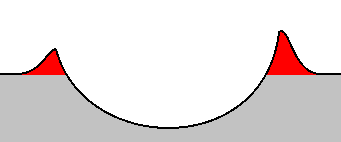Talk:Rim (coin)/Early page history
Coins
[edit]The rim of a coin is the sharp circular (or other shaped) edge which surrounds the coin design.
This is the part which exceeds the area of the die which strikes the coin during production, and as a result is pushed upward and sharpened to form a sort of border around the coin's design.
For accessibility purposes, the rim of the coin is sometimes milled with certain patterns in order for the blind to more easily distinguish between coins. In Australia, the two dollar coin has periodically distributed around its edge a short set of grooves, which alternate between the smooth rim, whilst the one dollar coin has a larger set of grooves, and the similar sized ten cent coin has grooves continuously about its edge.
Craters
[edit]The rim of a crater is the part that extends above the height of the local surface, usually in a circular or elliptical pattern. In a more specific sense, the rim may refer to the circular or elliptical edge that represents the uppermost tip of this raised portion. If there is no raised portion, the rim simply refers to the inside edge of the curve where the flat surface meets the curve of the crater bottom.
The above diagram shows a side view of a crater, with a raised rim, highlighed in red.
Firearms
[edit]A rim is an edge on the bottom of ammunition which helps to extract a casing out of the chamber of a barrel with the help of an extractor. On rimed ammunition, the rim is wider than the casing diameter, on rimless ammunition the rim dimensions do not exceed the casing diameter.
General meaning
[edit]In general, a rim is the circular edge of a circular open, as on the top of a jar or the inside edge of a manhole.
Other meanings
[edit]For the sexual practice, see rimming.
In an automotive context, see wheel.
{{split}}

